An equivalence relation is a relation which "looks like" ordinary equality of numbers, but which may hold between other kinds of objects. Here are three familiar properties of equality of real numbers:
1. Every number is equal to itself: ![]() for all
for all ![]() .
.
2. Equalities can be "reversed": If ![]() and
and ![]() , then
, then ![]() .
.
3. You can "chain" equalities together: If ![]() and
and ![]() and
and ![]() , then
, then ![]() .
.
These three properties are captured in the axioms for an equivalence relation.
Definition. An equivalence
relation on a set X is a relation ![]() on X such that:
on X such that:
1. ![]() for all
for all ![]() . (The relation is reflexive.)
. (The relation is reflexive.)
2. If ![]() , then
, then ![]() . (The relation is symmetric.)
. (The relation is symmetric.)
3. If ![]() and
and ![]() , then
, then ![]() . (The relation is transitive.)
. (The relation is transitive.)
Example. Show that the less-than relation ![]() on the set of real numbers is not an equivalence
relation. What about the relation
on the set of real numbers is not an equivalence
relation. What about the relation ![]() ? For no real number x is it true that
? For no real number x is it true that ![]() , so reflexivity never holds.
, so reflexivity never holds.
If x and y are real numbers and ![]() , it is false that
, it is false that ![]() . For example,
. For example, ![]() is true, but
is true, but ![]() is false.
is false.
It is true that if ![]() and
and ![]() , then
, then ![]() . Thus,
. Thus, ![]() is transitive.
is transitive.
Suppose instead I consider less-than-or-equal-to, the relation ![]() on
on ![]() .
.
Reflexivity now holds, since for any ![]() it is true that
it is true that ![]() . Transitivity holds just as before.
. Transitivity holds just as before.
However, symmetry still doesn't hold: ![]() , but
, but ![]() . Thus,
. Thus, ![]() is not an equivalence relation.
is not an equivalence relation.![]()
Example. (a) Is the relation whose graph is drawn below an equivalence relation?
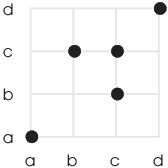
(b) Is the relation whose graph is drawn below an equivalence relation?
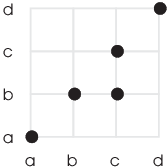
(c) Is the relation whose graph is drawn below an equivalence relation?
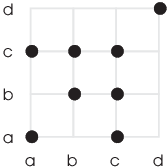
(a) The relation is not an equivalence relation. ![]() is not in the relation, so the relation is not
reflexive.
is not in the relation, so the relation is not
reflexive.![]()
(b) ![]() is in the relation, but
is in the relation, but ![]() is not. Therefore, the relation is not symmetric, so
it's not an equivalence relation.
is not. Therefore, the relation is not symmetric, so
it's not an equivalence relation.![]()
(c) This relation is reflexive and symmetric. However, ![]() and
and ![]() are in the relation, but
are in the relation, but ![]() is not. The relation is not transitive, and therefore
it's not an equivalence relation.
is not. The relation is not transitive, and therefore
it's not an equivalence relation.![]()
Example. A relation is defined on ![]() by
by
![]()
Check each axiom for an equivalence relation. If the axiom holds, prove it. If the axiom does not hold, give a specific counterexample.
![]() but
but ![]() , and
, and ![]() . Hence,
. Hence, ![]() and the
relation is not reflexive.
and the
relation is not reflexive.
Suppose ![]() . Then
. Then ![]() , so
, so ![]() . Hence,
. Hence, ![]() . The relation is symmetric.
. The relation is symmetric.
![]() , because
, because ![]() and
and ![]() .
.
![]() , because
, because ![]() and
and ![]() .
.
However, ![]() , as I showed above. Hence, the
relation is not transitive.
, as I showed above. Hence, the
relation is not transitive.![]()
Example. Define a relation ![]() on
on ![]() by
by
![]()
Check each axiom for an equivalence relation. If the axioms holds, prove it. If the axiom does not hold, give a specific counterexample.
For all ![]() ,
,
![]()
Therefore, ![]() for all x, and
for all x, and ![]() is reflexive.
is reflexive.
Suppose ![]() . This means that
. This means that ![]() . By commutativity of addition,
. By commutativity of addition,
![]() . Hence,
. Hence, ![]() . Therefore,
. Therefore, ![]() is symmetric.
is symmetric.
Transitivity does not hold.
![]()
![]()
However, ![]() , because
, because
![]()
Therefore, ![]() and
and ![]() do not imply
do not imply ![]() .
.![]()
Example. A relation is defined on ![]() by
by
![]()
Check each axiom for an equivalence relation. If the axiom holds, prove it. If the axiom does not hold, give a specific counterexample.
In words, the definition says two pairs are related if either their first components are equal or their second components are equal.
![]() , because the first components are
both a and hence equal.
, because the first components are
both a and hence equal.
Suppose ![]() . Then either
. Then either ![]() or
or ![]() . In the first case, if
. In the first case, if ![]() , then
, then ![]() ,
because their first components are equal:
,
because their first components are equal: ![]() implies
implies ![]() . In the second case,
if
. In the second case,
if ![]() , then
, then ![]() , because their second components are
equal:
, because their second components are
equal: ![]() implies
implies ![]() .
.
![]() , because their first components
are equal. And
, because their first components
are equal. And ![]() , because their
second components are equal. But
, because their
second components are equal. But ![]() , because neither their first nor
their second components are equal.
, because neither their first nor
their second components are equal.![]()
Example. Define a relation on ![]() by
by ![]() if and only if
if and only if ![]() is divisible by 3.
is divisible by 3.
Check each axiom for an equivalence relation. If the axiom holds, prove it. If the axiom does not hold, give a specific counterexample.
For example, ![]() , since
, since ![]() , and 24 is divisible by 3. And
, and 24 is divisible by 3. And
![]() , since
, since ![]() , and -9 is divisible by 3.
, and -9 is divisible by 3.
However, ![]() , since
, since ![]() , and 34 is
not divisible by 3.
, and 34 is
not divisible by 3.
If x is an integer, ![]() is divisible by 3.
Therefore,
is divisible by 3.
Therefore, ![]() for all
for all ![]() , and
, and ![]() is reflexive.
is reflexive.
Suppose x and y are integers. If ![]() , then
, then ![]() is divisible by 3. Say
is divisible by 3. Say ![]() , where
, where ![]() . Now
. Now

Therefore, ![]() is divisible by 3, so
is divisible by 3, so ![]() . Hence,
. Hence, ![]() is symmetric.
is symmetric.
You might be wondering how I knew to start with "![]() ". I reasoned
backwards on scratch paper this way.
". I reasoned
backwards on scratch paper this way.
To prove symmetry, I had to show that if ![]() , then
, then ![]() .
.
By the definition of ![]() , that's the same as
showing: If
, that's the same as
showing: If ![]() is divisible by 3, then
is divisible by 3, then ![]() is divisible by 3.
is divisible by 3.
If ![]() being divisible by 3 is going to force
being divisible by 3 is going to force ![]() to be divisible by 3, there's probably be some
connection involving 3,
to be divisible by 3, there's probably be some
connection involving 3, ![]() , and
, and ![]() .
.
As in many proofs, you often reach a point where you need to play around with the stuff you have. You don't know in advance what will work, and there isn't a step-by-step method for finding out. You have to experiment.
So you think: "3?" "![]() ?" "
?" "![]() ?" You might
try various ways of combining the expressions ... and maybe you
realize that
?" You might
try various ways of combining the expressions ... and maybe you
realize that ![]() and
and ![]() (notice the 3's!), and then:
(notice the 3's!), and then:
![]()
Since the "then" part of what I want to prove involves ![]() , I'll solve the last equation for
, I'll solve the last equation for ![]() :
:
![]()
And there's the equation I started with.
Now suppose x, y, and z are integers. Assume ![]() and
and ![]() . This means that
. This means that
![]() is divisible by 3, and
is divisible by 3, and ![]() is divisible by 3. I'll express these as equations:
is divisible by 3. I'll express these as equations:
![]()
![]()
I want to show that ![]() is divisible by 3. My proof
looks like this so far, with the assumptions at the top and the
conclusion at the bottom.
is divisible by 3. My proof
looks like this so far, with the assumptions at the top and the
conclusion at the bottom.
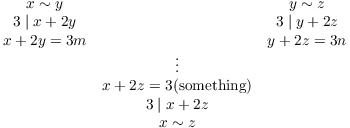
How can I get from ![]() and
and ![]() to
to ![]() ? Make what you've got look like what you
want. What I have involves x, y, and z, but what I want seems to
involve only x and z. It looks like I want to get rid of the y's. How
can I do that? One way is to solve the second equation for y:
? Make what you've got look like what you
want. What I have involves x, y, and z, but what I want seems to
involve only x and z. It looks like I want to get rid of the y's. How
can I do that? One way is to solve the second equation for y:
![]()
Then plug into the first:

I look at my target equation ![]() . Make what you've got look like what you
want. I need
. Make what you've got look like what you
want. I need ![]() on the left side, so I'll just
do algebra to force it to happen:
on the left side, so I'll just
do algebra to force it to happen:

The left side is what I want (![]() ), but I need
), but I need ![]() on the right ... oh, just factor
out 3:
on the right ... oh, just factor
out 3:
![]()
I'll plug this derivation into the proof outline above:
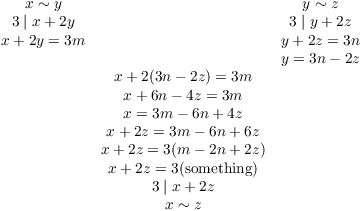
This is a complete proof of transitivity, though some people might
prefer more words. Thus, ![]() is an equivalence
relation.
is an equivalence
relation.
Notice that if you were presented with this proof without any of the scratchwork or backward reasoning, it might look a little mysterious: You can see each step is correct, but you might wonder how anyone would think of doing those things in that order. This is an unfortunate consequence of the way math is often presented: After the building is finished, the scaffolding is removed, and you may then wonder how the builders managed to get the materials up to the roof!
The lesson here is that you should not look at a finished proof and assume that the person who wrote it had a flash of genius and then wrote the thing down from start to finish. While that can happen, more often proofs involve messing around and attempts that don't work and lots of scratch paper!
Equivalence relations give rise to partitions. As a real-world example, consider a deck of playing cards. It is divided into 4 suits: spades, hearts, diamonds, and clubs. Define two cards in the deck to be equivalent if they belong to the same suit. This is an equivalence relation. Every card in the deck belongs to one and only one suit, which is the set of all cards in the same suit as the given card.
In general, if ![]() is an equivalence relation on a set
X and
is an equivalence relation on a set
X and ![]() , the
equivalence class of x consists of all the elements of X which
are equivalent to x. In the previous example, the suits are the
equivalence classes.
, the
equivalence class of x consists of all the elements of X which
are equivalent to x. In the previous example, the suits are the
equivalence classes.
Definition. Let X be a set. A partition of X is a collection of subsets ![]() of X such that:
of X such that:
1. ![]() .
.
2. If ![]() and
and ![]() , then
, then ![]() .
(The subsets
.
(The subsets ![]() are pairwise
disjoint.)
are pairwise
disjoint.)
Thus, the elements of a partition are like the pieces of a jigsaw puzzle:
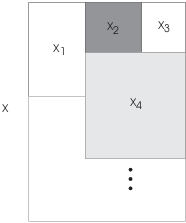
Example. Why don't the following sets
partition the set of integers ![]() ?
?
(a)
![]()
(b)
![]()
(a) Every integer is in one of these sets, but the two sets overlap
(at 0).![]()
(b) The sets don't overlap, but -1 is not contained in either
set.![]()
Example. Prove: If X is a set and S is a
subset of X, then ![]() is a partition of X.
is a partition of X.
If ![]() , then either
, then either ![]() or
or ![]() . In the second case,
. In the second case,
![]() . Thus, every element of X is either in S
or in
. Thus, every element of X is either in S
or in ![]() .
.
If ![]() , then
, then ![]() and
and ![]() , which is a
contradiction. Hence, S and
, which is a
contradiction. Hence, S and ![]() are disjoint.
are disjoint.
Therefore, ![]() is a partition of X.
is a partition of X.![]()
Here is how equivalence relations are related to partitions.
Theorem. Let X be a set. An equivalence
relation ![]() on X gives rise to a partition of X
into equivalence classes. Conversely, a
partition of X gives rise to an equivalence relation on X whose
equivalence classes are exactly the elements of the partition.
on X gives rise to a partition of X
into equivalence classes. Conversely, a
partition of X gives rise to an equivalence relation on X whose
equivalence classes are exactly the elements of the partition.
Proof. Suppose ![]() is an equivalence relation on X. If
is an equivalence relation on X. If ![]() , let
, let
![]()
Thus, ![]() is the equivalence class of x. Now
is the equivalence class of x. Now ![]() , so
, so ![]() . Clearly,
. Clearly, ![]() .
.
Now some of the ![]() 's may be identical; throw out the
duplicates. This means that I have
's may be identical; throw out the
duplicates. This means that I have ![]() 's where
's where ![]() , and Y is a
subset of X --- and if
, and Y is a
subset of X --- and if ![]() and
and ![]() , then
, then ![]() . Since I've
just thrown out duplicates, I still have
. Since I've
just thrown out duplicates, I still have ![]() . I will have a
partition if I show that the remaining
. I will have a
partition if I show that the remaining ![]() 's don't intersect.
's don't intersect.
Suppose ![]() and
and ![]() , but
, but ![]() . I'll show
that this gives a contradiction. By definition,
. I'll show
that this gives a contradiction. By definition, ![]() and
and ![]() , so by symmetry and
transitivity,
, so by symmetry and
transitivity, ![]() .
.
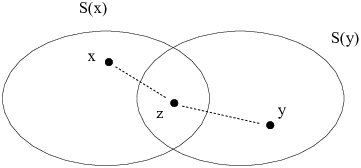
Now I'll show ![]() . I'll show each is
contained in the other. Suppose
. I'll show each is
contained in the other. Suppose ![]() . Then
. Then ![]() , but
, but ![]() , so
, so ![]() , and
, and ![]() .
.
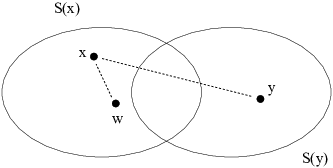
This shows ![]() . But the argument clearly
works the other way around, so
. But the argument clearly
works the other way around, so ![]() . Hence,
. Hence, ![]() .
.
Since I threw out all the duplicates earlier, this is a
contradiction. Hence, there is no such z, which means ![]() . This means that the
. This means that the ![]() 's for
's for ![]() partition X.
partition X.
Conversely, suppose ![]() is a
partition of X. Define a relation on X by saying
is a
partition of X. Define a relation on X by saying ![]() if and only if
if and only if ![]() for some
for some ![]() .
.
If ![]() , then
, then ![]() for some i because
for some i because ![]() --- to be in the union means
you're in one of the sets in the union. Now x is in the same
--- to be in the union means
you're in one of the sets in the union. Now x is in the same ![]() as itself ---
as itself --- ![]() --- so
--- so ![]() . It's reflexive.
. It's reflexive.
If ![]() , then
, then ![]() for some i. Obviously,
for some i. Obviously, ![]() , so
, so ![]() . It's symmetric.
. It's symmetric.
Finally, if ![]() and
and ![]() , then
, then ![]() and
and ![]() for some i
and j. Now
for some i
and j. Now ![]() , but this can only
happen if
, but this can only
happen if ![]() . Then
. Then ![]() , so
, so ![]() .
.
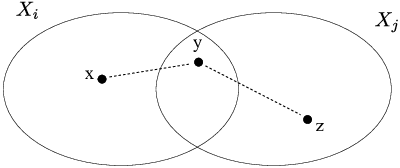
It's transitive, and hence it's an equivalence relation.
The equivalence classes of ![]() are exactly the
are exactly the ![]() 's, by construction.
's, by construction.![]()
Example. Suppose ![]() . Consider the following
partition of X:
. Consider the following
partition of X:
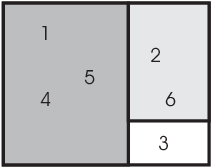
What is the equivalence relation defined by this partition?
The equivalence relation defined by this partition is: ![]() for all
for all ![]() , and
, and
![]()
In other words, 1, 4, and 5 are equivalence to each other, 2 and 6
are equivalent, and 3 is only equivalent to itself.![]()
Example. Consider the relation on ![]() defined by
defined by ![]() if and only if
if and only if
![]() --- that is, if
--- that is, if ![]() is an integer.
is an integer.
Check each axiom for an equivalence relation. If the axioms holds, prove it. If the axiom does not hold, give a specific counterexample.
Let ![]() . Then
. Then ![]() . Therefore,
. Therefore, ![]() , and
, and ![]() is reflexive.
is reflexive.
Suppose ![]() , so
, so ![]() . Since the negative of an integer
is an integer,
. Since the negative of an integer
is an integer, ![]() . Hence,
. Hence, ![]() , and
, and ![]() is symmetric.
is symmetric.
Suppose ![]() and
and ![]() . Then
. Then ![]() and
and ![]() . But the sum of integers is an
integer, so
. But the sum of integers is an
integer, so
![]()
Therefore, ![]() , and
, and ![]() is transitive. Thus,
is transitive. Thus, ![]() is an equivalence relation.
is an equivalence relation.
Here's a typical equivalence class for ![]() :
:
![]()
A little thought shows that all the equivalence classes look like
like one: All real numbers with the same "decimal part".
Each class will contain one element --- 0.3942 in the case of the
class above --- in the interval ![]() . Therefore, the set of equivalence
classes of
. Therefore, the set of equivalence
classes of ![]() looks like
looks like ![]() . Moreover, since
. Moreover, since ![]() , it's as if this interval had its ends
"glued together":
, it's as if this interval had its ends
"glued together":

This is an important use of equivalence relations in mathematics ---
to "glue together" or identify parts of a set to
create a new set.![]()
Example. Let ![]() , the x-y plane. Define
, the x-y plane. Define ![]() to mean that
to mean that
![]()
In words, this means that ![]() and
and ![]() are the same distance from the origin.
are the same distance from the origin.
Show that this is an equivalence relation, and sketch the partition
of ![]() into equivalence classes that it
determines.
into equivalence classes that it
determines.
Since ![]() , it follows that
, it follows that ![]() . Hence, the relation is
reflexive.
. Hence, the relation is
reflexive.
Suppose ![]() , so
, so
![]()
Then
![]()
Hence, ![]() . Hence, the relation is
symmetric.
. Hence, the relation is
symmetric.
Suppose ![]() and
and ![]() . Then
. Then
![]()
Hence,
![]()
Therefore, ![]() . Hence, the relation is
transitive. This show that
. Hence, the relation is
transitive. This show that ![]() is an equivalence
relation.
is an equivalence
relation.
The resulting partition of ![]() into equivalence
classes consists of circles centered at the origin. The origin is in
an equivalence class by itself.
into equivalence
classes consists of circles centered at the origin. The origin is in
an equivalence class by itself.

Notice that the axioms for a partition are satisfied: Every point in
the plane lies in one of the circles, and no point lies in two of the
circles.![]()
Example. An equivalence relation is defined on
the set ![]() by:
by:
![]()
List the elements of the equivalence classes of ![]() .
.
Two numbers are in the same class if they differ by a multiple of 3. So the equivalence classes are:
![]()
Copyright 2019 by Bruce Ikenaga